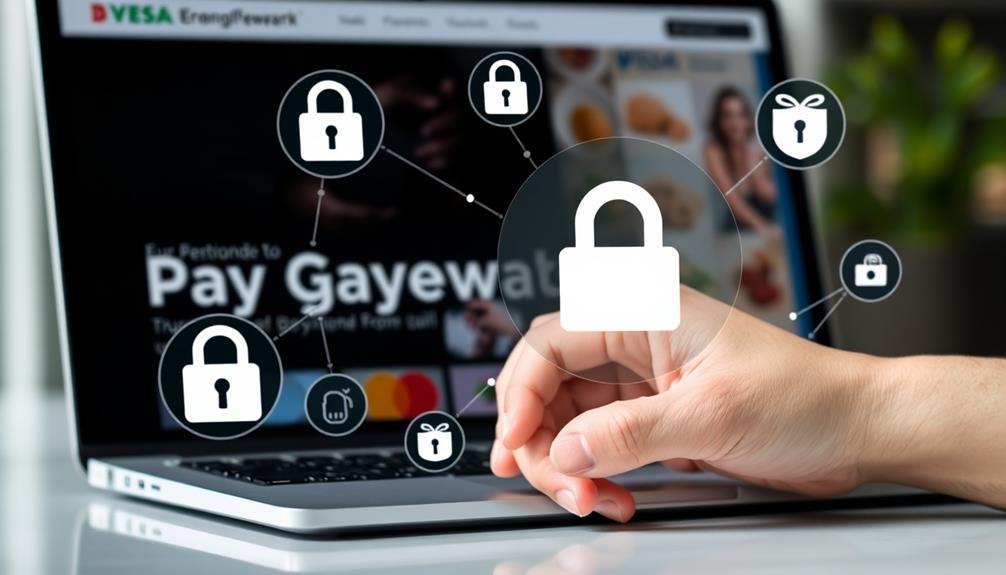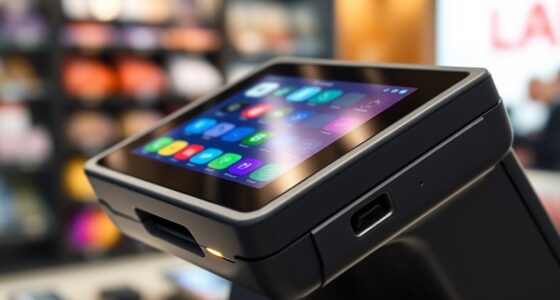Network tokenization helps you reduce not‑present fraud by replacing sensitive card data with unique tokens that are useless to cybercriminals. When used during online or mobile payments, these tokens make stolen information ineffective for future transactions, which cuts fraud rates markedly—sometimes by double digits. Plus, combining tokenization with advanced security methods creates a safer checkout environment. Keep exploring to discover how these security innovations work together to protect your digital transactions even further.
Key Takeaways
- Replaces static card data with dynamic tokens, making stolen information useless for future transactions.
- Implements dynamic CVV that changes per transaction, preventing reuse of compromised data.
- Combines tokenization with biometric authentication, ensuring only authorized users complete online payments.
- Creates a layered security environment, reducing the likelihood of successful fraud attempts.
- Enhances compliance and security protocols, leading to a double-digit reduction in not-present fraud rates.

Network tokenization has become a vital tool in combating fraud by replacing sensitive payment data with unique, non-sensitive tokens during transactions. This technology ensures that your actual card details are never directly transmitted or stored during the payment process, markedly reducing the risk of data breaches and unauthorized access. When you make a purchase online or through a mobile app, instead of sending your real card number, a randomly generated token is used, making it much harder for cybercriminals to intercept valuable information. This process not only protects your financial data but also helps merchants comply with strict security standards like PCI DSS, fostering a safer digital payment environment.
Network tokenization secures payments by replacing sensitive data with unique tokens, reducing fraud risks and ensuring safer transactions.
One of the key advantages of network tokenization is its ability to facilitate advanced authentication methods, such as biometric authentication. When you use fingerprint scans, facial recognition, or other biometric methods, the system can verify your identity in real-time before completing the transaction. This layered security approach makes it far more difficult for fraudsters to impersonate you, even if they obtain your tokenized data. The combination of tokenization and biometric authentication creates a seamless, yet highly secure, checkout experience that minimizes the chances of unauthorized transactions. Additionally, implementing compliance standards like PCI DSS enhances overall security and trustworthiness in digital payments. Utilizing encryption protocols further secures data during transmission, adding an extra layer of protection against cyber threats. Implementing robust security measures such as tokenization significantly reduces the likelihood of successful cyberattacks targeting payment data. Furthermore, adopting token management strategies can optimize the lifecycle and security of tokens over time.
Additionally, network tokenization introduces features like the dynamic CVV, which further enhances security for not-present transactions—those made online or via mobile devices where you’re not physically present with your card. Unlike static CVVs printed on your card, dynamic CVVs are generated anew for each transaction or after a short period. This means that even if a hacker manages to steal your tokenized data, the dynamic CVV makes it nearly impossible to reuse or exploit the information for future fraudulent activities. By continuously changing the verification code, the system effectively renders stolen data useless, reducing fraud by double digits compared to traditional static methods.
Furthermore, advanced security protocols built into network tokenization help prevent other types of digital scams and phishing attempts, creating an overall more secure payment ecosystem. Together, these innovations—tokenization, biometric authentication, and dynamic CVV—create a multi-layered defense that makes fraud markedly more difficult. Network tokenization acts as the backbone, replacing sensitive data with tokens that are meaningless to cybercriminals. Meanwhile, biometric authentication ensures that only you can authorize transactions, and dynamic CVV provides an additional, ever-changing security barrier during online purchases. If you’re concerned about fraud, embracing these technologies offers a proactive way to safeguard your financial information and reduce the likelihood of falling victim to digital scams. By leveraging these tools, you benefit from faster, more secure transactions that protect your data without sacrificing convenience.
Frequently Asked Questions
How Does Tokenization Impact Customer Checkout Experience?
When you use tokenization during checkout, your experience becomes quicker and more secure. It replaces sensitive payment data with a secure token, reducing the risk of fraud and making transactions safer. This improves customer trust because you feel confident your information is protected. As a result, checkout feels seamless, and you’re more likely to return, knowing your payments are secure and your trust is valued.
What Industries Benefit Most From Network Tokenization?
When it comes to industry-specific solutions, you’ll find network tokenization benefits many sectors, especially retail, travel, and healthcare. It’s a win-win, helping you stay ahead of compliance considerations while minimizing fraud risks. These industries handle sensitive data daily, making tokenization a vital tool. By safeguarding customer info, you reduce fraud by double digits, giving you peace of mind and boosting trust in your services.
Are There Any Security Risks Associated With Token Storage?
You should know that storing tokens can have security risks if there are token storage vulnerabilities. If these tokens aren’t properly protected, attackers could access sensitive data. Effective encryption key management is vital because it guarantees tokens are safely encrypted and decrypted only by authorized systems. To minimize risks, you need strong security measures, regular audits, and secure token storage practices that prevent unauthorized access and protect against potential breaches.
How Does Token Lifecycle Management Work?
You might think managing tokens is simple, but effective token lifecycle management is vital. It involves generating, deploying, and securely retiring tokens at appropriate stages. Management strategies include automatic expiration, regular updates, and secure storage. This process ensures tokens stay valid only as long as needed, reducing fraud risk and maintaining security. Proper lifecycle management keeps your system resilient, making sure tokens serve their purpose without becoming vulnerabilities over time.
Can Tokenization Prevent Card-Not-Present Fraud Entirely?
You might wonder if tokenization can stop card-not-present fraud completely. While it substantially reduces risks, it can’t eliminate all threats. Digital wallets use token correlation to protect your data by replacing card details with secure tokens. This makes it harder for fraudsters to steal and misuse your information. However, combining tokenization with other security measures offers the best defense against CNP fraud, though no solution guarantees full prevention.
Conclusion
Think of network tokenization as a lock guarding your digital vault, turning your sensitive data into unbreakable symbols. Each token is a shield, preventing fraudsters from reaching your true information. As you embrace this technology, you’re lighting a beacon of security in a darkening landscape of cyber threats. With every token, you’re not just protecting transactions—you’re illuminating a safer path forward, where your trust remains untouched and your digital world stays secure.










